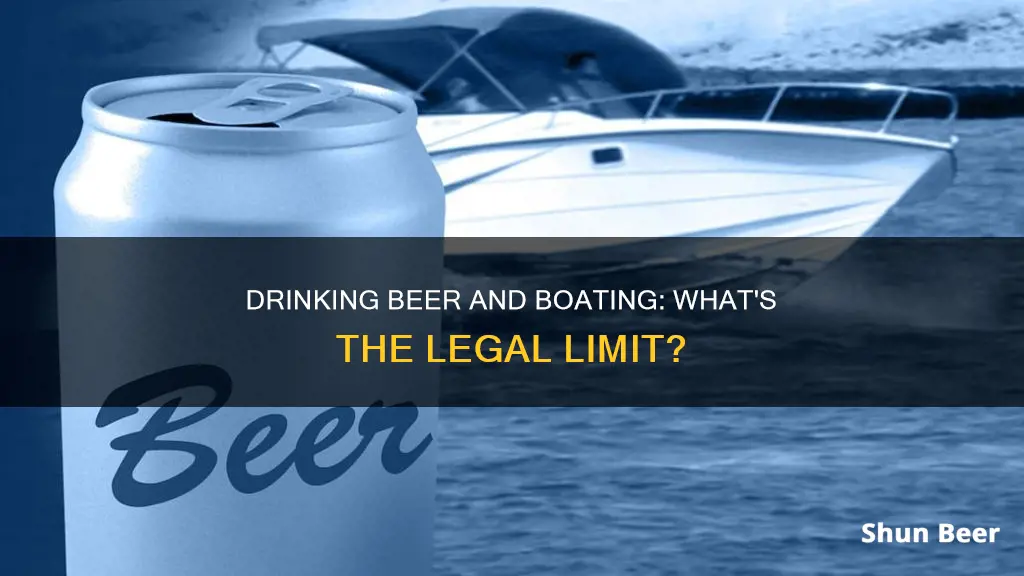
Drinking and driving is a dangerous and well-known no-go, but what about drinking a beer and driving a boat? It is illegal to drink and operate a boat in all 50 states, and the laws are similar to those for drinking and driving a car. The legal limit for drinking and driving a car is a blood alcohol concentration (BAC) of 0.08% g/dL, and the same is true for operating a boat. However, passengers on a boat are allowed to drink as long as it does not hinder the safe operation of the boat.
| Characteristics | Values |
|---|---|
| Legality of drinking and driving a boat | Illegal in all 50 states |
| Legal blood alcohol limit | 0.08% in most states |
| Penalties | Large fines, possible jail time, loss of boating/driving license, mandatory education classes, boat seizure and sale |
| Fatalities involving alcohol | Alcohol is involved in nearly half of all boating deaths |
What You'll Learn

Drinking and boating laws in the US
Penalties for BUI vary by state but can include large fines, possible jail time, and the loss of your driver's license. Some states also mandate enrollment in a substance abuse treatment program or an alcohol education class, and seizure or sale of the vessel. Underage drinkers may face more severe penalties, and many states have zero-tolerance laws for boating and drinking any amount of alcohol.
Boating under the influence can be extremely dangerous, even more so than driving a car. A person operating a boat must be aware of tides, currents, underwater obstacles, other boaters, people or objects in the water, and changing weather conditions. Alcohol impairs a person's judgment, reflexes, and reaction time, increasing the risk of accidents and injuries. It is best to avoid drinking and boating altogether and designate a non-drinking driver for the boat.
The Fizziness in Beer: How Carbonation Works
You may want to see also

Drinking and boating laws in Canada
According to the Criminal Code of Canada, it is illegal to operate a boat if you are impaired by drugs or alcohol. A person is considered "under the influence" if their Blood Alcohol Concentration (BAC) level is 80mg or higher, which is determined by a breathalyser or blood test. Impaired boating includes operating a vessel while having a higher than acceptable blood concentration level of THC and cocaine, in combination with alcohol or independently.
The penalties for drinking and boating in Canada include fines, imprisonment, suspension of your driver's license, and increased insurance costs. The specific penalties vary across provinces and territories, but the minimum penalties for the entire country are as follows:
1st Offence: A minimum fine of $600
2nd Offence: A minimum fine of $600 and at least 14 days in prison
3rd or Subsequent Offence: A minimum fine of $600 and at least 90 days in prison
It is important to note that passengers may legally consume alcohol on board a boat in Canada if certain requirements are met. The boat must be equipped with permanent cooking facilities, sleeping facilities, and a permanent toilet. Additionally, the boat must be anchored or secured alongside a dock. It is the responsibility of the boat operator to ensure compliance with these requirements and to remain sober to ensure the safety of all passengers.
After-Work Beers: Finding the Perfect Number
You may want to see also

Penalties for drinking and driving a boat
Drinking and boating is a dangerous combination, and boat operators can face serious consequences for drinking and boating. Operating a boat under the influence of alcohol is a federal offence in the US and a criminal offence in Canada. The penalties for drinking and driving a boat vary depending on the jurisdiction, but they can include large fines, jail time, loss of boating and/or driving privileges, mandatory substance abuse treatment, and seizure or sale of the vessel.
In the US, each state enforces its own unique penalties for those caught boating under the influence (BUI). These penalties can include large fines, possible jail time, and a potential effect on your driver's license. For example, in Alabama, the penalties for BUI include large fines and/or jail time, plus suspension of the operator's certification. In California, the penalties include large fines, jail time, and possible suspension of your driver's license.
In Canada, the penalties for boating under the influence also vary by province or territory. The minimum penalties for a first offence are a fine of $600. For a second offence, the minimum penalties are a $600 fine and at least 14 days in prison. For a third or subsequent offence, the minimum penalties are a $600 fine and at least 90 days in prison. These are just the minimum penalties, and the maximum fines and penalties will vary by province.
It is important to note that the legal blood alcohol concentration (BAC) limit for operating a boat is typically the same as that for driving a car, which is 0.08% in the US and Canada. However, the specific laws and regulations regarding drinking and driving a boat can vary by jurisdiction, so it is important to check the local laws before operating a boat while under the influence of alcohol.
Old Beer: Is It Safe to Drink After a Year?
You may want to see also

Alcohol consumption rules for passengers
While drinking alcohol on a boat is not illegal, it is important to drink in moderation and be aware of the laws and potential penalties regarding alcohol consumption and boat operation. In many places, the laws for drinking and operating a boat are similar to those for drinking and driving a car. The legal limit for drinking and driving a car is typically a blood alcohol concentration (BAC) of 0.08% g/dL, and the same is true for operating a boat. This limit applies regardless of whether the boat has a motor and includes canoes, kayaks, and rowboats.
In the US, all 50 states have laws regarding alcohol consumption and boat operation, and boating under the influence (BUI) is illegal in every state. The penalties for BUI vary from state to state but may include loss or suspension of boating license, mandatory substance abuse treatment, loss of driving privileges, and seizure or sale of the vessel. Underage drinkers may face more severe penalties, and many states have zero-tolerance laws for any alcohol consumption while boating.
In Canada, it is an offence under the Criminal Code to operate a boat while impaired by drugs or alcohol, with a BAC limit of 0.08%. Each territory has its own rules and regulations, but they all prohibit operating a boat while drinking. The penalties for boating under the influence in Canada include fines and prison sentences, with minimum fines of $600 and prison sentences of up to 90 days for repeat offences.
In Queensland, Australia, the skipper of a boat must have a BAC of less than 0.05, and they are also responsible for the safety of passengers and their alcohol consumption. Police can ask for a saliva sample to detect the presence of drugs, and there is zero tolerance for boating under the influence of drugs. If convicted of any drink or drug driving offence involving a recreational vessel, your marine licence can be cancelled or suspended.
Draught Beer: How Does It Work?
You may want to see also

The dangers of drinking and boating
Drinking and boating is a dangerous combination that can lead to fatal consequences. In the US, alcohol is the leading known factor in boating fatalities, with nearly 4,500 accidents and over 700 deaths recorded in 2016. The risks of drinking and boating are similar to those of drinking and driving, if not more hazardous.
The legal limit for drinking and driving in most states is a blood alcohol concentration (BAC) of 0.08% g/dL, and the same is true for operating a boat. However, a boater is more likely to become impaired than a driver, drink for drink. The marine environment, with its motion, vibration, engine noise, sun, wind, and spray, accelerates a drinker's impairment. These stressors cause fatigue, affecting a boater's coordination, judgment, and reaction time, making them more prone to accidents.
Alcohol affects a person's cognitive abilities and judgment, making it harder to process information, assess situations, and make good choices. It impairs physical performance, with balance problems, lack of coordination, and increased reaction time. Vision is also affected, with decreased peripheral vision, reduced depth perception, and night vision. Alcohol also disrupts the inner ear, making it difficult for someone who falls into the water to distinguish up from down, increasing the risk of drowning.
The combination of sun and water can enhance the effects of alcohol, impairing judgment, vision, balance, and coordination. It can also lead to a false sense of warmth, delaying the realization of hypothermia in cold water. Alcohol lowers inhibitions, reduces decision-making capabilities, and slows reaction time and reflexes, making it challenging to navigate tides, currents, and other boaters.
The consequences of boating under the influence (BUI) can be severe, including large fines, suspension or revocation of boating privileges, and jail terms. A BUI can also impact driving records and insurance coverage. It is essential to understand the risks and legal consequences of drinking and boating to ensure the safety of everyone on board and other boaters.
Workplace Attire: Beer Shirts, Appropriate or Not?
You may want to see also
Frequently asked questions
Drinking a beer while driving a boat will bring you up to a 0.02 BAC. The legal limit for drinking and driving is a blood alcohol concentration (BAC) of 0.08% g/dL, and the same is true for operating a boat. So, technically, you can have a beer and still be within the legal limit, but it is not recommended.
Boating can be even more hazardous than operating a motor vehicle, especially when impaired by alcohol. A person has to be aware of tides, currents, objects in the water, other boaters, and the weather. There are no roads or lines on the water telling boaters where they can and can’t drive. Alcohol can also make it more likely that a person will fall overboard into the water.
The consequences for operating a boat under the influence differ slightly from state to state, but all carry hefty fines and possible jail time. For example, in Alabama, a first offence could be a fine of up to $2,100 and/or a sentence of up to one year in jail, in addition to the suspension of the operator’s certification for 90 days.







